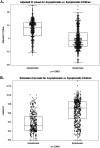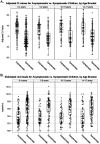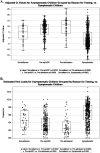Comparison of Upper Respiratory Viral Load Distributions in Asymptomatic and Symptomatic Children Diagnosed with SARS-CoV-2 Infection in Pediatric Hospital Testing Programs
- PMID: 33093026
- PMCID: PMC7771452
- DOI: 10.1128/JCM.02593-20
Comparison of Upper Respiratory Viral Load Distributions in Asymptomatic and Symptomatic Children Diagnosed with SARS-CoV-2 Infection in Pediatric Hospital Testing Programs
Abstract
The distribution of upper respiratory viral loads (VL) in asymptomatic children infected with severe acute respiratory syndrome coronavirus 2 (SARS-CoV-2) is unknown. We assessed PCR cycle threshold (Ct) values and estimated VL in infected asymptomatic children diagnosed in nine pediatric hospital testing programs. Records for asymptomatic and symptomatic patients with positive clinical SARS-CoV-2 tests were reviewed. Ct values were (i) adjusted by centering each value around the institutional median Ct value from symptomatic children tested with that assay and (ii) converted to estimated VL (numbers of copies per milliliter) using internal or manufacturer data. Adjusted Ct values and estimated VL for asymptomatic versus symptomatic children (118 asymptomatic versus 197 symptomatic children aged 0 to 4 years, 79 asymptomatic versus 97 symptomatic children aged 5 to 9 years, 69 asymptomatic versus 75 symptomatic children aged 10 to 13 years, 73 asymptomatic versus 109 symptomatic children aged 14 to 17 years) were compared. The median adjusted Ct value for asymptomatic children was 10.3 cycles higher than for symptomatic children (P < 0.0001), and VL were 3 to 4 logs lower than for symptomatic children (P < 0.0001); differences were consistent (P < 0.0001) across all four age brackets. These differences were consistent across all institutions and by sex, ethnicity, and race. Asymptomatic children with diabetes (odds ratio [OR], 6.5; P = 0.01), a recent contact (OR, 2.3; P = 0.02), and testing for surveillance (OR, 2.7; P = 0.005) had higher estimated risks of having a Ct value in the lowest quartile than children without, while an immunocompromised status had no effect. Children with asymptomatic SARS-CoV-2 infection had lower levels of virus in their nasopharynx/oropharynx than symptomatic children, but the timing of infection relative to diagnosis likely impacted levels in asymptomatic children. Caution is recommended when choosing diagnostic tests for screening of asymptomatic children.
Keywords: COVID-19; SARS-CoV-2; diagnostics; pediatric infectious disease.
Copyright © 2020 American Society for Microbiology.
Figures



Similar articles
-
Clinical Course and Molecular Viral Shedding Among Asymptomatic and Symptomatic Patients With SARS-CoV-2 Infection in a Community Treatment Center in the Republic of Korea.JAMA Intern Med. 2020 Nov 1;180(11):1447-1452. doi: 10.1001/jamainternmed.2020.3862. JAMA Intern Med. 2020. PMID: 32780793 Free PMC article.
-
Comparison of the simultaneous conjunctiva and oropharynx-nasopharynx swab results in patients applying to the SARS-CoV-2 outpatient clinic for the first time.J Med Virol. 2021 Jul;93(7):4516-4522. doi: 10.1002/jmv.26981. Epub 2021 May 3. J Med Virol. 2021. PMID: 33783859 Free PMC article.
-
SARS-CoV-2 viral RNA load dynamics in the nasopharynx of infected children.Epidemiol Infect. 2021 Jan 11;149:e18. doi: 10.1017/S095026882100008X. Epidemiol Infect. 2021. PMID: 33427152 Free PMC article.
-
COVID-19: lessons to date from China.Arch Dis Child. 2020 Dec;105(12):1146-1150. doi: 10.1136/archdischild-2020-319261. Epub 2020 May 12. Arch Dis Child. 2020. PMID: 32398322 Review.
-
Viral dynamics in the Upper Respiratory Tract (URT) of SARS-CoV-2.Infez Med. 2020 Dec 1;28(4):486-499. Infez Med. 2020. PMID: 33257622
Cited by
-
Cycle Threshold Value as a Predictor of Severity and Intensive Care Unit Admission for Children Presenting to the Emergency Department With COVID-19: A Single-Center Experience From Saudi Arabia.Cureus. 2022 Jul 6;14(7):e26614. doi: 10.7759/cureus.26614. eCollection 2022 Jul. Cureus. 2022. PMID: 35936119 Free PMC article.
-
Defining the pediatric response to SARS-CoV-2 variants.Front Immunol. 2023 May 25;14:1200456. doi: 10.3389/fimmu.2023.1200456. eCollection 2023. Front Immunol. 2023. PMID: 37304275 Free PMC article. Review.
-
Silence of the Lambs: The Immunological and Molecular Mechanisms of COVID-19 in Children in Comparison with Adults.Microorganisms. 2021 Feb 7;9(2):330. doi: 10.3390/microorganisms9020330. Microorganisms. 2021. PMID: 33562210 Free PMC article. Review.
-
Diagnostic Accuracy of Rapid Antigen Tests for COVID-19 Detection: A Systematic Review With Meta-analysis.Front Med (Lausanne). 2022 Apr 7;9:870738. doi: 10.3389/fmed.2022.870738. eCollection 2022. Front Med (Lausanne). 2022. PMID: 35463027 Free PMC article.
-
Preoperative SARS-CoV-2 Screening Fails to Detect Viral Particles Prior to Airway Surgery.Laryngoscope. 2022 Aug;132(8):1665-1667. doi: 10.1002/lary.29906. Epub 2021 Oct 19. Laryngoscope. 2022. PMID: 34643283 Free PMC article.
References
-
- Zachariah P, Johnson CL, Halabi KC, Ahn D, Sen AI, Fischer A, Banker SL, Giordano M, Manice CS, Diamond R, Sewell TB, Schweickert AJ, Babineau JR, Carter RC, Fenster DB, Orange JS, McCann TA, Kernie SG, Saiman L, Columbia Pediatric COVID-19 Management Group. 2020. Epidemiology, clinical features, and disease severity in patients with coronavirus disease 2019 (COVID-19) in a children's hospital in New York City, New York. JAMA Pediatr 174:e202430. doi:10.1001/jamapediatrics.2020.2430. - DOI - PMC - PubMed
-
- Park YJ, Choe YJ, Park O, Park SY, Kim YM, Kim J, Kweon S, Woo Y, Gwack J, Kim SS, Lee J, Hyun J, Ryu B, Jang YS, Kim H, Shin SH, Yi S, Lee S, Kim HK, Lee H, Jin Y, Park E, Choi SW, Kim M, Song J, Choi SW, Kim D, Jeon BH, Yoo H, Jeong EK. 2020. Contact tracing during coronavirus disease outbreak, South Korea, 2020. Emerg Infect Dis 26:2465–2468. doi:10.3201/eid2610.201315. - DOI - PMC - PubMed
Publication types
MeSH terms
LinkOut - more resources
Full Text Sources
Medical
Miscellaneous

